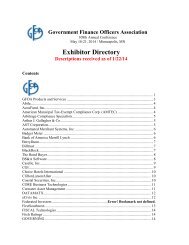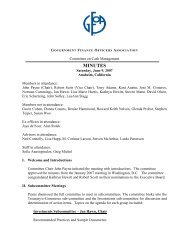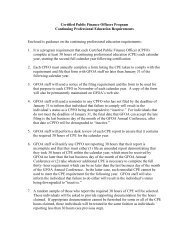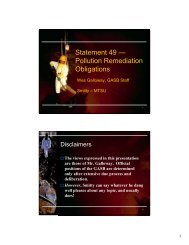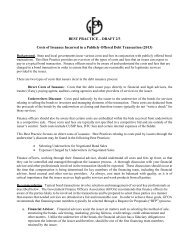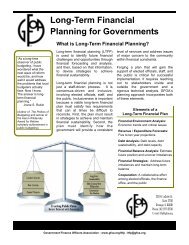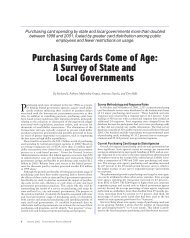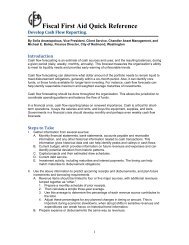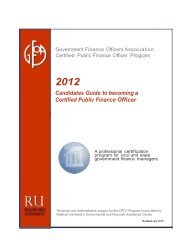Structuring the Revenue Forecasting Process - Government Finance ...
Structuring the Revenue Forecasting Process - Government Finance ...
Structuring the Revenue Forecasting Process - Government Finance ...
Create successful ePaper yourself
Turn your PDF publications into a flip-book with our unique Google optimized e-Paper software.
Exhibit 1: Sales Tax Data from <strong>the</strong> City of Colorado Springs<br />
14<br />
12<br />
10<br />
Millions<br />
8<br />
6<br />
4<br />
2<br />
0<br />
January 2006<br />
June 2006<br />
November 2006<br />
April 2007<br />
September 2007<br />
February 2008<br />
July 2008<br />
December 2008<br />
May 2009<br />
October 2009<br />
March 2010<br />
August 2010<br />
January 2011<br />
June 2011<br />
November 2011<br />
April 2012<br />
Relationships between Variables. Correlation analysis is<br />
useful for determining important relationships between variables<br />
that could aid in forecasting. Forecasters use correlation<br />
analysis to compare revenues with predictive variables such<br />
as economic or demographic statistics, looking for strong relationships<br />
that can be used in quantitative forecasting or just to<br />
provide additional insight for judgmental forecasts. The most<br />
useful statistic is <strong>the</strong> correlation coefficient, often known simply<br />
as “r.” It measures <strong>the</strong> extent to which two variables move<br />
in <strong>the</strong> same or opposite directions and expresses this movement<br />
as a positive or a negative number. An r value of 1.0 is<br />
a perfect positive relationship, and -1.0 represents a perfect<br />
inverse relationship. A value of a zero indicates no relationship.<br />
Generally, an r value of more than 0.8 or less than -0.8<br />
would indicate a relationship worth exploring fur<strong>the</strong>r.<br />
A limitation of <strong>the</strong> standard correlation coefficient, however,<br />
is that it might not account for a lagging relationship<br />
between two variables. For example, enrollment would be<br />
a significant driver of tuition fees at a community college.<br />
And unemployment is often thought to motivate people to go<br />
back to school, so it would presumably have an impact on<br />
enrollment, as well. However, people do not typically enroll<br />
in a college course immediately after losing a job or failing to<br />
find employment. Hence, a correlation analysis of enrollment<br />
and regional unemployment figures would probably show a<br />
weak correlation for <strong>the</strong> same time period, but comparing<br />
enrollment to unemployment figures from earlier periods<br />
might show a stronger correlation.<br />
STEP 4: SELECT METHODS<br />
The next step is to determine <strong>the</strong> quantitative and/or qualitative<br />
forecasting methods to be used. <strong>Forecasting</strong> research<br />
has shown that “statistically sophisticated or complex methods<br />
do not necessarily produce more accurate forecasts than<br />
simpler ones.” 4<br />
While complex techniques might get more<br />
accurate answers in particular cases, simpler techniques tend<br />
to perform just as well or better, on average. Also, simpler<br />
techniques require less data, less expertise on <strong>the</strong> part of<br />
<strong>the</strong> forecaster, and less overall effort to use. Fur<strong>the</strong>r, simpler<br />
methods are easier to explain to <strong>the</strong> audience for <strong>the</strong> forecast.<br />
It makes sense to heed Einstein’s advice and make things “as<br />
simple as possible, but not simpler.”<br />
In <strong>the</strong> spirit of Einstein’s guidance, <strong>the</strong> GFOA has adapted<br />
Exhibit 2 from <strong>the</strong> work of J. Scott Armstrong. 5<br />
Armstrong<br />
originally published a flow chart to guide forecasters through<br />
Why Simple is Better — The Devil is in <strong>the</strong> Details<br />
Why do simple methods tend to outperform more complex<br />
ones? <strong>Forecasting</strong> science luminary Spyros Makridakis believes<br />
it is because complex methods try to find patterns that aren’t<br />
really <strong>the</strong>re by creating a tight statistical “fit” to historical data. *<br />
These false patterns are <strong>the</strong>n projected forward. Conversely,<br />
simple methods ignore such patterns and just extrapolate<br />
trends.<br />
* From: Spyros Makridakis, Robin M. Hogarth and Anil Gaba, “Why Forecasts Fail.<br />
What to Do Instead,” MIT Sloan Management Review, Winter 2010.<br />
12 <strong>Government</strong> <strong>Finance</strong> Review | October 2012



